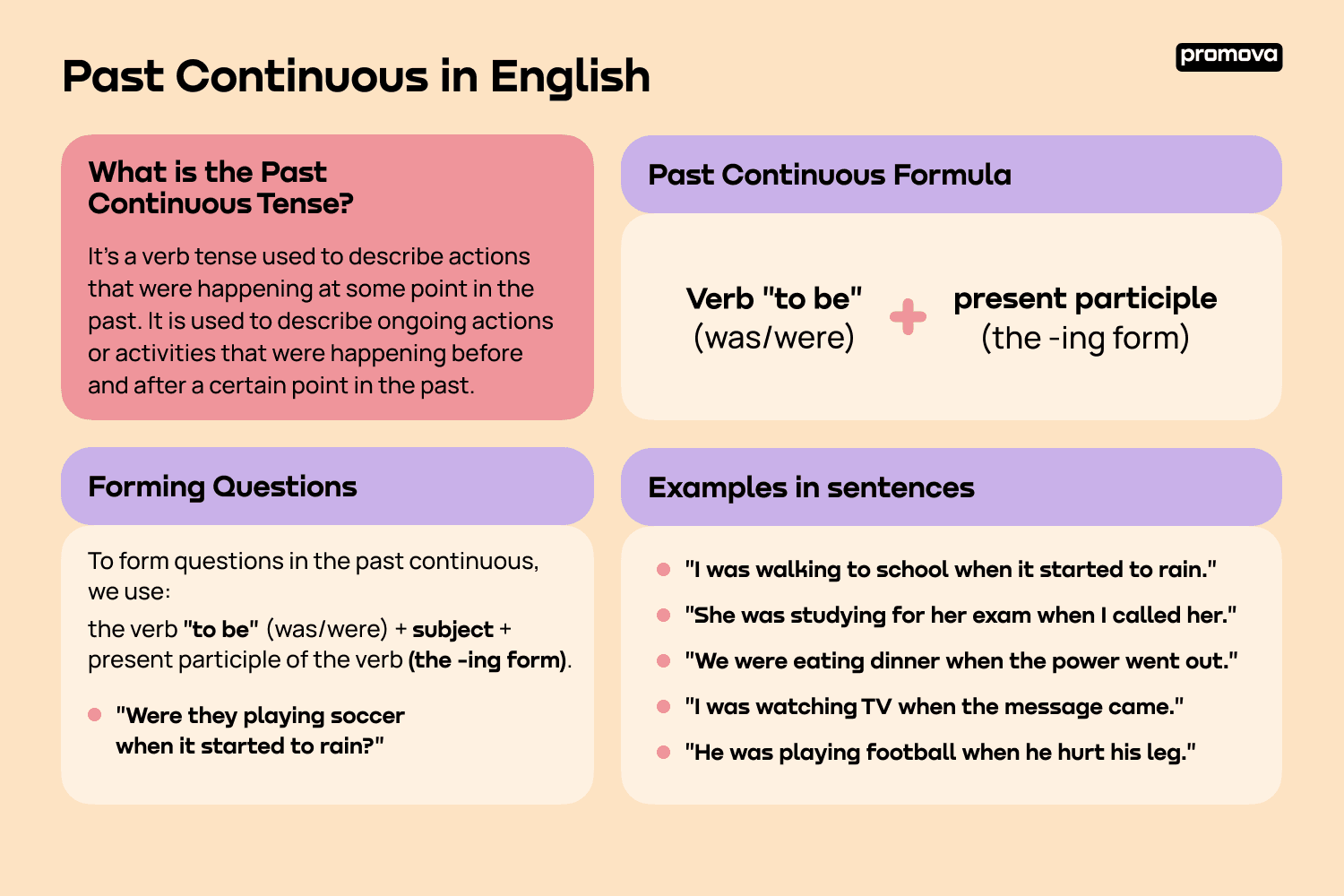Past Continuous in English
Contents
Welcome to the world of English grammar! Today we will learn about the past continuous tense - what it is, how to use it, and how to form it. We will also look at examples of the past continuous tense in sentences, and learn how to use it for interruptions, unfinished actions, and parallel actions. Let's get started!
What is the Past Continuous Tense?
It's a verb tense used to describe actions that were happening at some point in the past. It is used to describe ongoing actions or activities that were happening before and after a certain point in the past. This tense is also known as the "progressive tense" because it describes ongoing actions. For example, "I was watching TV when the phone rang."
The past continuous tense comes together with the verb "to be" (was/were) with the present participle of the verb (the -ing form). For example, the past continuous form of the verb "talk" is "was/were talking". 
Past Continuous Formula
As mentioned earlier, we use "to be" (was/were) with the present participle (the -ing form) to form this tense. For example, the past continuous form of the verb "eat" is "was/were eating".
In other words, the formula is:
Verb "to be" + present participle of verb = past continuous
Examples of the Past Continuous Tense in Sentences
Examples of the past continuous tense in sentences:
- "I was walking to school when it started to rain."
- "She was studying for her exam when I called her."
- "We were eating dinner when the power went out."
- "I was watching TV when the message came."
- "He was playing football when he hurt his leg."
How to Use the Past Continuous
The past continuous tense helps us describe ongoing actions or activities that were happening before and after a certain point in the past. For example, "I was eating dinner when the phone rang." In this sentence, the action of eating dinner was happening before and after the phone rang.
The past continuous tense also helps describe two actions that were happening at the same time in the past. So, "I was studying while she was watching TV." In this sentence, both actions (studying and watching TV) were happening at the same time.
Forming Questions in Past Continuous
To form questions in the past continuous, we use the same structure as when forming questions in the present continuous tense. We use the verb "to be" (was/were) + subject + present participle of the verb (the -ing form). For example, "Were you watching TV when the phone rang?"
More examples:
- "Were they playing soccer when it started to rain?"
- "Was she studying for her exam when you called her?"
- "Were you eating dinner when the power went out?"
- "Was he watching TV when the message came?"
- "Were we playing games when you broke your leg?"
Adverbs of Frequency in the Past Continuous
Adverbs of frequency (e.g. usually, always, sometimes, etc.) can be used with the past continuous tense to express how often something was happening in the past. For example, "I was usually watching TV on Sunday evenings."
More examples:
- "She was always studying for her exams on Monday mornings."
- "We were sometimes eating dinner together on the weekends."
- "He was rarely playing soccer in the rain."
- "They were usually walking to school in the morning."
- "I was occasionally watching TV when I should have been doing my homework."
2
How to Use the Past Continuous for Interruptions
The past continuous tense is often used to describe an interruption in an ongoing action or activity. For example, "I was eating dinner when the phone rang." In this sentence, the action of eating dinner was interrupted by the phone ringing.
More examples:
- "She was studying for her exam when you called her."
- "We were playing games when you broke your leg."
- "He was watching TV when the message came."
- "They were walking to school when it started to rain."
- “I was doing my chores when my parents came home.”
How to Use the Past Continuous for unfinished actions
The past continuous tense can also be used to describe unfinished actions or activities. For example, "I was studying for my exam when I fell asleep." In this sentence, studying was unfinished because the speaker fell asleep.
More examples:
- "He was watching TV when the power went out."
- "They were walking to school when it started to rain."
- "She was eating dinner when the phone rang."
- "We were playing games when you broke your leg."
How to Use the Past Continuous for Parallel Actions
The past continuous tense can also be used to describe two actions that were happening at the same time in the past. For example, "I was studying while she was watching TV." In this sentence, both actions (studying and watching TV) were happening at the same time.
More examples:
- "He was playing soccer while they were walking to school."
- "We were eating dinner while she was studying for her exams."
- "She was reading a book while I was doing my homework."
- "They were talking on the phone while I was watching TV."
- "He was cooking dinner while she was cleaning the kitchen."
Summary
We looked at what the past continuous tense is, how to use it, and how to form it. We also looked at examples of the past continuous tense in sentences, adverbs of frequency, and common verbs used in the past continuous tense. You can use it for interruptions, unfinished actions, and parallel actions. Now that you understand the past continuous tense, try practicing to apply it in real conversations!



Comments